Finding Old Homes for Sale Your Complete Guide
Discover how to find and buy charming old homes for sale. Our guide offers practical tips on searching, inspecting, and renovating historic properties.
Posted by
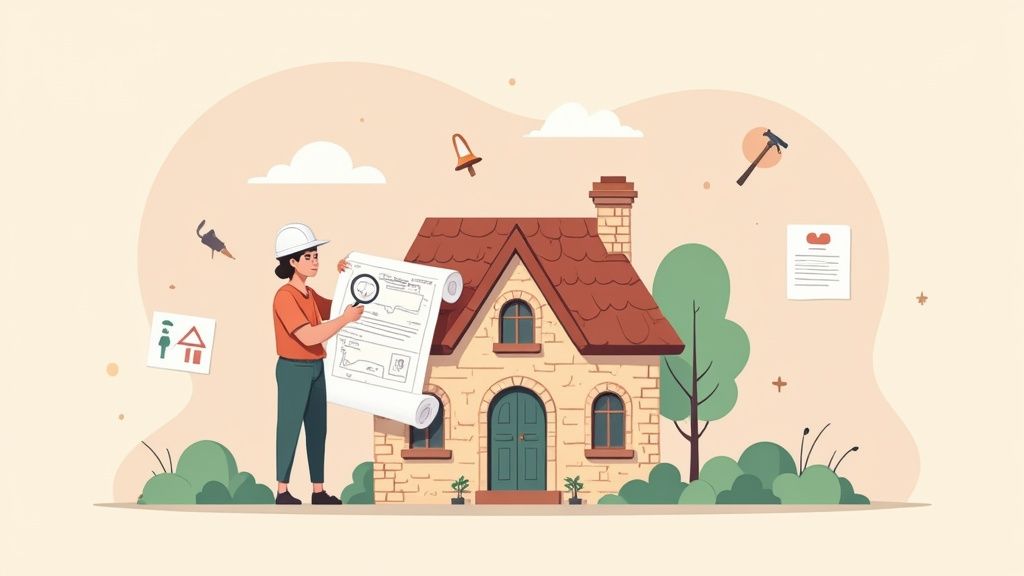
There's a certain magic to finding classic old homes for sale. It's more than just a real estate transaction; it's like you're stepping into a story already in progress. People are often pulled in by the unique character, the solid craftsmanship, and the sense of history that you just don't find in modern builds. They’re looking for a home that feels like it has a soul.
Why We're Still Drawn to Historic Homes
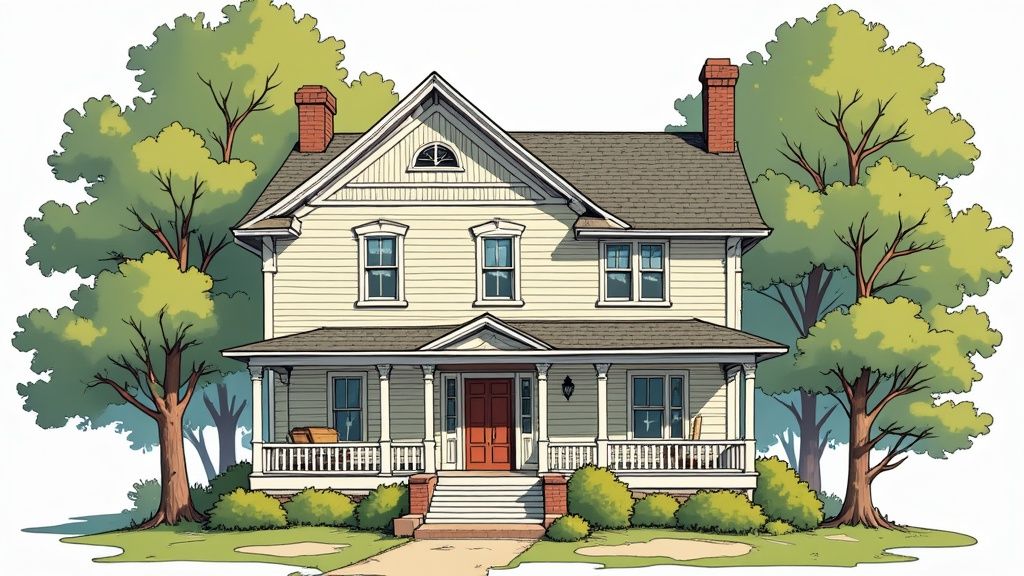
You can feel the difference the moment you walk through the door of a home with a past. It’s in the weight of a solid wood door, the gentle creak of original hardwood floors, and the intricate trim work carved by someone’s hands a century ago. These details create a warmth and personality that a brand-new house simply can't mimic.
But the appeal isn't purely sentimental. From a practical standpoint, these homes are usually nestled in established, walkable neighborhoods with beautiful, mature trees and a real sense of community. This kind of prime real estate often makes for a solid investment that holds its value, even when the market gets shaky.
The Lasting Appeal of Craftsmanship and Character
When you step inside a historic home, you're entering a space built with an entirely different mindset. Forget the mass-produced materials of today; these properties were often built with superior materials and an incredible eye for detail.
It's these kinds of features that really capture a buyer's imagination:
- Unique Architectural Styles: Think about it—stately Victorians, cozy Craftsman bungalows, and elegant Colonials each offer a distinct design that makes a statement.
- Solid Construction: Many of these homes were built with old-growth lumber, plaster walls, and stone foundations. These materials were chosen for one reason: they last.
- Irreplaceable Details: You just don't see things like stained-glass windows, custom built-in cabinetry, and handcrafted millwork anymore. They add a layer of artistry that's missing from most modern homes.
For a lot of people, buying an old house isn't just about owning a piece of property. It's about becoming the next caretaker of its history. You're writing the next chapter in a story that started long before you were even born.
Navigating the Market for Older Properties
The market for existing homes—which is mostly made up of older properties—is a huge part of the real estate world. In the United States, for instance, existing home sales have averaged around 4.06 million annually since 1968. That's a steady, consistent demand.
This figure was hovering around 4.01 million in July 2025, which just goes to show that the interest in homes with a bit of history isn't fading. If you want to dig into the numbers yourself, Trading Economics offers some great detailed sales data.
Think of this guide as your personal roadmap for this journey. We’ll walk you through everything, from figuring out what a property listing really means to spotting potential red flags during an inspection. We'll cover how to get the right financing and even how to plan your first renovation, all while making sure you preserve the very soul of your new home. It’s a real adventure—one that blends history, creativity, and a smart investment.
Mastering the Search for Historic Properties
Hunting for the perfect old home is a different beast altogether. You can't just hop on a standard real estate site and expect to find a diamond in the rough. A generic search for "3 bed, 2 bath" will flood you with new builds, burying the historic gems you’re actually looking for. The key is to cut through that noise and focus your search on properties with a story to tell.
Your first move should be to get savvy with the advanced filters on real estate search portals. The "year built" filter is your best friend here. Setting a maximum year, like 1950 or even 1930, instantly weeds out the modern stuff. But don't just stop there. Try searching for specific architectural keywords like "Victorian," "Craftsman," or "Tudor." It’s a simple trick, but it dramatically refines your results.
Expanding Your Search Beyond the MLS
While online listings are a good start, some of the most incredible historic homes are never publicly listed. This is where old-fashioned networking and knowing the right people can make all the difference. You’ve got to connect with the local community that lives and breathes these old houses.
A niche real estate agent who specializes in historic properties is worth their weight in gold. You can usually spot them by their websites or social media, which are often filled with beautiful period homes. These agents have a network of sellers who are patiently waiting for a buyer who will appreciate the home's unique character, not just see it as a teardown.
Another fantastic resource is your local historical society or preservation group. The people in these organizations are deeply passionate about protecting the area’s architectural heritage.
- Show up to their meetings or events: It's the best way to meet long-time residents and other preservation enthusiasts.
- Ask about "pocket listings": They often get wind of homeowners who are thinking about selling long before a "For Sale" sign ever goes up.
- Inquire about at-risk properties: Sometimes, they know of significant homes that have fallen into neglect and desperately need a new owner to bring them back to life.
The real secret to finding unique old homes is often about who you know. By building genuine relationships within the local historic preservation community, you can uncover opportunities that most people never even hear about.
This targeted approach is more critical than ever in the current market. Recent housing market analysis from J.P. Morgan shows that the supply of existing homes for sale is still hovering near historic lows. At the same time, new construction has ramped up to its highest point since 2007, making it even harder to sift through the listings to find older, character-rich properties.
The search for an old home involves a unique set of tools and community connections. The table below breaks down where to focus your energy.
A Comparison of Resources to Find Old Homes
| Resource | Best For Finding | Key Advantage | Potential Drawback |
|---|---|---|---|
| MLS/Real Estate Portals | Publicly listed historic homes in good to fair condition. | Wide reach and easy access to basic property data. | High competition; can be difficult to filter out irrelevant listings. |
| Specialist Real Estate Agents | Off-market "pocket listings" and homes with specific historic value. | Deep network and expertise in historic property transactions. | May have a limited inventory in a specific geographic area. |
| Local Historical Societies | At-risk properties, unlisted homes, and deep historical context. | Insider knowledge and access to a passionate community. | Information is often informal and requires proactive networking. |
| "Driving for Dollars" | Neglected or forgotten properties that aren't on the market. | Discovering truly hidden gems that no one else has found. | Time-consuming and requires significant effort to track down owners. |
Ultimately, a combination of these resources will yield the best results. Don't rely on just one avenue; cast a wide net to increase your chances of finding that perfect property.
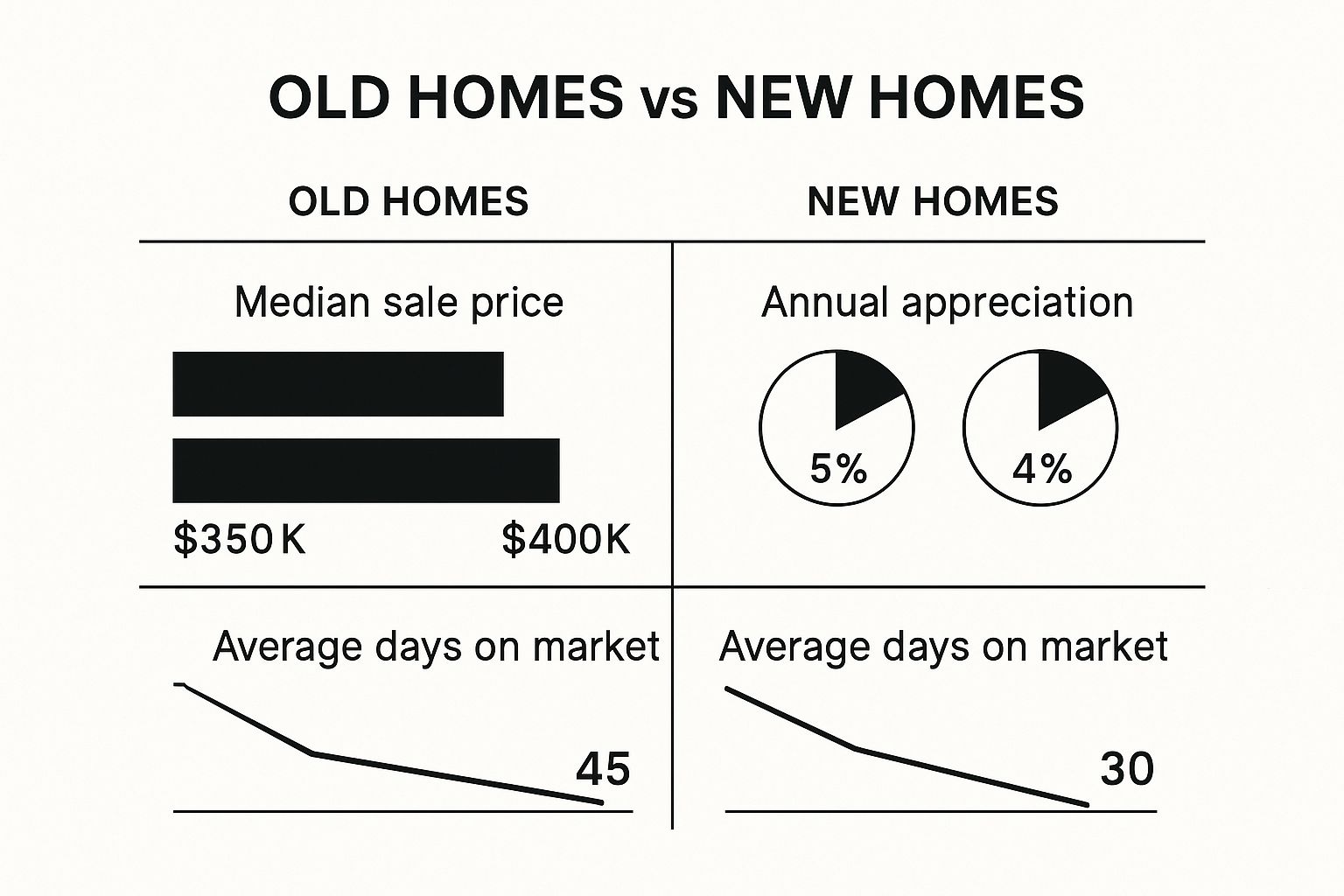
This data shows an interesting trend: while older homes sometimes sell for a bit less, they often appreciate faster. They also tend to stay on the market longer, which can be a huge advantage for a savvy buyer during negotiations.
Setting Realistic Expectations for Your Search
As you dive in, it’s vital to keep your expectations in check. The idea of a flawless, move-in-ready historic home is mostly a myth. The reality is that nearly every old house will need work, whether it’s simple cosmetic updates or a full-blown overhaul of its major systems.
Think of yourself as a property detective. When you find a promising listing, go beyond the curated photos. Use tools like Google Street View to check out the neighborhood and see how the home and surrounding properties have evolved over time. This kind of initial legwork helps you figure out if you're looking at a manageable project or a potential money pit before you even step foot inside.
Remember, searching for an old home is a marathon, not a sprint. But when you finally find that one-of-a-kind property with soul and a story, the entire journey becomes worth it.
How to Inspect an Old Home Like a Pro
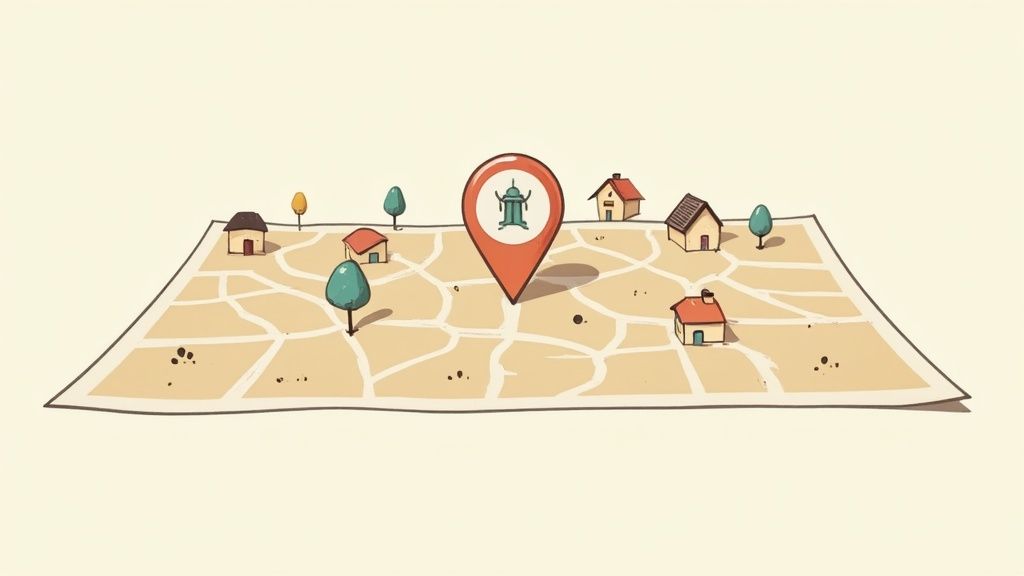
It’s incredibly easy to get swept up in the romance of an old house. You see those original hardwood floors, the charming built-ins, the wavy glass in the windows, and you're already picturing your life there. But a successful purchase is all about looking past the surface to understand what’s really going on underneath.
A proactive, thorough inspection is the single most important thing that separates a dream restoration project from a financial nightmare. Think of yourself as a detective during this phase. Your job is to ask the right questions and spot the clues that others might miss. This isn't about finding flaws just to kill the deal; it's about getting the full picture so you can make a smart decision and negotiate from a place of real knowledge.
Starting with the Foundation and Structure
Everything—and I mean everything—in a house rests on its foundation. It's the absolute most critical part of your inspection. In older homes, you’ll probably find foundations made of stone, brick, or early poured concrete, and each has its own quirks and potential problems.
Look for more than just the hairline settling cracks you’d expect in an old structure. You need to pay close attention to the serious stuff:
- Horizontal cracks: These are a huge warning sign. They often point to serious hydrostatic pressure pushing against the foundation walls, a much bigger beast to tackle than simple vertical cracks.
- Bowing or bulging walls: Get your eye level with the foundation walls and sight down their length. Any noticeable curve or bulge inward is a major red flag for structural instability.
- Crumbling mortar: With stone or brick foundations, check the mortar between the blocks. If it’s turning to dust, it's a sign that the entire structure could be compromised, letting in moisture and pests.
Once you’re inside, the floors will tell you a story. A gentle slope in a 100-year-old home is pretty normal, but if you feel a pronounced sag or a bouncy, trampoline-like feeling under your feet, you could be looking at rotted joists or failing support beams in the basement or crawlspace.
Uncovering Issues in Electrical and Plumbing Systems
Next, let's talk about the home's guts: the electrical and plumbing systems. Outdated systems aren't just inefficient; they can be downright dangerous and are almost always expensive to replace.
The electrical system is my first stop. Be on the lookout for knob-and-tube wiring, an old-school method you’ll find in homes built before the 1940s. While it’s not inherently a fire hazard if left untouched, it’s ungrounded, can’t be covered with modern insulation, and many insurance companies won't even cover it. That’s a deal-breaker for a lot of lenders.
"Many homebuyers fall in love with the aesthetics of an old home but forget that its core systems weren't designed for modern life. Upgrading a home's entire electrical and plumbing infrastructure can easily cost tens of thousands of dollars, a factor that must be included in your total budget."
The plumbing needs just as much scrutiny. Older homes often have galvanized steel or, in very old properties, lead pipes. Galvanized pipes corrode from the inside out, which kills your water pressure and can leach rust into your water. A quick test? Turn on a few faucets at the same time. If the flow drops to a trickle, you can bet you’re dealing with old galvanized pipes.
This kind of detailed assessment is more critical than ever, especially in a competitive market. The U.S. housing market alone is valued at nearly $50 trillion, and with a recent dip in foreign investment, domestic buyers are all competing for a limited supply of these character-filled older homes. Having a deep understanding of a property's true condition gives you a massive advantage.
Evaluating Windows, Roofs, and Insulation
The home’s "envelope"—the parts that protect it from the elements—is your final area of focus. This is all about energy efficiency and preventing costly damage. Original single-pane windows are gorgeous, but they're terrible insulators and can make your energy bills skyrocket. Check for rot in the wooden sashes and sills and test if they even open and close properly anymore.
The roof is another one of those massive-ticket items you can't afford to ignore. From the ground, use binoculars if you have them and look for shingles that are missing, curling, or cracked. See any dark streaks? That could be algae or a sign of moisture issues. Inside, any water stain on a ceiling or in the attic is a clear signal of a leak—past or present—that needs to be dealt with immediately.
Before you get too far down the road, it's also smart to dig into the property's past. A home's history can reveal a lot. You can learn how to research property history in our detailed guide to uncover past owners, building permits, and old modifications that might affect the home today.
Working with a Specialized Home Inspector
While doing your own walkthrough is a great first step, it never, ever replaces a professional. But here’s the key: not all home inspectors are the same. When you're looking at old homes for sale, you need to hire someone who specializes in historic or older properties. A standard inspector who mostly sees new construction might miss the nuances.
Here are a few questions I always recommend asking a potential inspector:
- How much of your work is on homes built before 1950?
- Are you familiar with things like knob-and-tube wiring, balloon framing, and cast-iron plumbing?
- Will you physically go into the crawlspace and attic, or do you just peek in from the hatch?
- Do you use tools like a thermal imaging camera to spot moisture or insulation gaps?
A truly great inspector is also a great teacher. They’ll walk you through the property, explain what they’re seeing in plain English, and give you a detailed report that becomes your roadmap for future repairs. That report is also one of your most powerful tools for negotiating the final price. This professional assessment is your best defense against accidentally buying a beautiful money pit.
What to Know About Historic District Rules and Financing
Finding a charming old house is the fun part. The real work begins when you start digging into the unique financial and legal hoops you'll need to jump through. When you’re looking at old homes for sale, especially those in a designated historic district, your due diligence has to go way beyond the standard checklist. You aren't just buying a house; you're stepping into the role of a caretaker for a piece of local history, and that comes with its own set of rules and rewards.
This part of the journey can feel like a lot, I know. But getting a handle on these details upfront is exactly how you protect your investment and avoid some very expensive surprises later on.
Playing by the Rules of a Historic District
If that dream home you found is located within a local historic district, you’ll need to get acquainted with the preservation commission. Think of them as the guardians of the neighborhood's character. Their job is to make sure any changes made to a home's exterior fit the historical vibe of the area.
This doesn't mean your hands are tied. It just means you have to work within a certain framework.
Here's what that typically looks like in practice:
- Exterior Changes: Simple things you wouldn't think twice about on a modern home—like changing the paint color, swapping out a front door, or updating windows—will almost certainly need the commission's blessing. They often have a pre-approved list of historic paint colors to choose from.
- The Window Debate: This is a big one. Commissions almost always prefer that you repair original windows rather than replace them. If they’re beyond saving, you’ll likely be required to install new ones that match the original style and material, like true divided-light wood windows instead of off-the-shelf vinyl inserts.
- Additions and New Structures: Dreaming of a new garage or a screened-in porch? The design, size, and materials will all be scrutinized to ensure the addition looks like it belongs with the original house.
My best advice? Before you even think about making an offer, find the district's design guidelines. You can usually find them on your local government's website. Reading through them will give you a very clear picture of what you can and can’t do.
Getting the Right Loan for an Old Home
Financing an old house, especially one that needs a lot of love, is a different ballgame than getting a conventional mortgage. Most lenders get nervous about loaning money for a property that needs major work right away. Thankfully, there are loan products specifically designed for this situation.
The FHA 203(k) loan is probably the most well-known. It’s a government-backed mortgage that lets you roll the home's purchase price and the estimated renovation costs into one single loan. It's a fantastic tool for buyers who've found a diamond in the rough that needs immediate polishing.
Another great choice is the Fannie Mae HomeStyle Renovation loan. It works a lot like the 203(k) but can be more flexible about the types of projects you can tackle. For both of these, you'll need to line up detailed contractor bids and have a solid plan in place before you can close, which is a good thing—it ensures the money is used wisely.
Don't let a home's need for repair scare you away from a great deal. With the right renovation loan, you can finance the purchase and the restoration simultaneously, turning a neglected property into your dream home with a single monthly payment.
The Challenge of Insuring an Old House
You might be surprised to find that getting homeowners insurance for an older property can be a bit of a headache. Insurers see things like old knob-and-tube wiring, galvanized plumbing, and aging roofs as huge risks. In fact, some companies will flat-out refuse to write a policy until those systems are updated.
The key here is to start shopping for insurance during your inspection period. Don't wait until the last minute. Be totally transparent with insurance agents about the home’s age and any issues you know about. You might have better luck with an insurer who specializes in older homes, as they understand the quirks and can offer policies that make sense.
Unlocking Historic Tax Credits
Now for the good news. One of the best-kept secrets of old-home ownership is the potential for some serious financial perks. To encourage people to preserve historic buildings, many federal, state, and local governments offer tax credits.
For instance, the Federal Historic Preservation Tax Incentives program provides a 20% income tax credit for the major rehab of historic, income-producing properties. While that one is for commercial or rental properties, many states have their own versions for regular homeowners. These credits can slash your renovation costs, sometimes saving you tens of thousands of dollars. It’s absolutely worth a few hours of research to see what programs are available in your state and city.
Making an Offer and Planning Your First Renovation
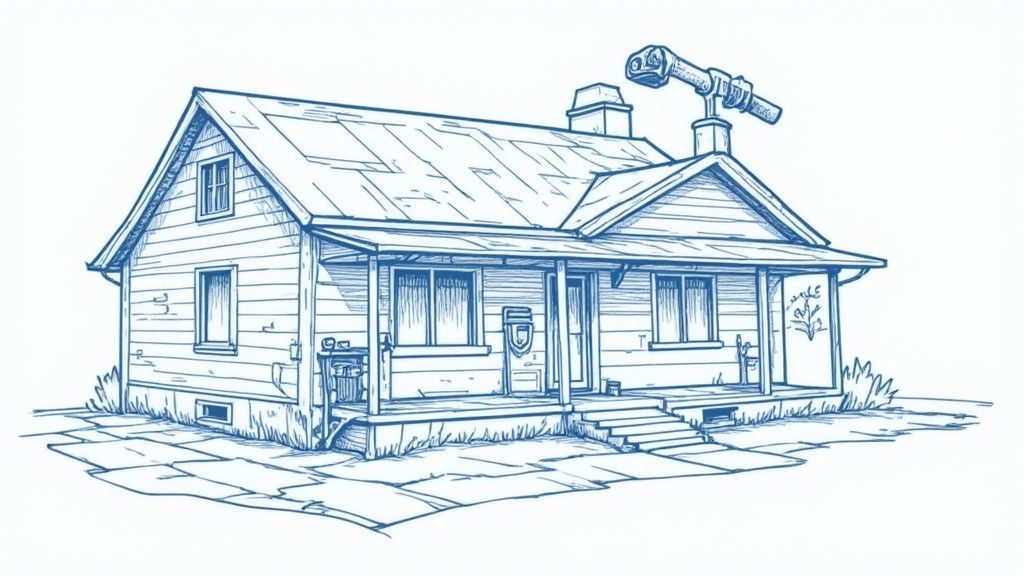
You’ve navigated the search, walked through what feels like a hundred properties, and finally found it. The one old home that just feels right. It's an incredible feeling, but now the real work begins. This is where smart strategy and careful planning take over, turning that charming old house into your home.
This is the moment all that due diligence pays off. The detailed report from your specialized inspector isn't just a list of problems—it’s your single most powerful negotiation tool. A strong offer on an old home isn't about being the highest bidder; it's about presenting a number that accurately reflects the property's real-world condition.
Crafting an Offer That Reflects Reality
When you’re looking at old homes for sale, the asking price is usually more of a suggestion than a final number. Your offer needs to be a direct reflection of the work that lies ahead. If your inspector found that the house needs a full electrical rewire—a project that can easily run $15,000 to $20,000—that cost absolutely needs to be factored into your bid.
Don't be shy about using that inspection report. When you can present the seller with a clear, itemized list of necessary repairs and back it up with professional cost estimates, your offer suddenly becomes very compelling. It grounds the negotiation in facts about the home's safety and livability, not just opinions.
For example, you could frame your offer like this: "We are offering $350,000, based on the $375,000 list price, less $25,000 to account for the necessary knob-and-tube electrical replacement and galvanized plumbing updates outlined in the attached inspection report." It’s professional, transparent, and difficult to argue against.
The goal isn't to lowball the seller. It's about reaching a fair price that acknowledges the immediate, necessary investment you're about to make. A well-documented offer proves you're a serious, informed buyer, not just someone fishing for a discount.
Creating Your Renovation Roadmap
Once those keys are in your hand, the adventure truly kicks off. It’s so tempting to jump straight into the fun stuff you’ve been daydreaming about, like picking out paint colors or designing a new kitchen. But a successful, on-budget renovation always starts with a clear, prioritized plan.
Your very first task should be creating a master list of every single project the house needs, from the absolutely critical to the purely cosmetic. Then, you'll want to split this list into two crucial categories: "Needs" and "Wants." This simple exercise is the foundation of a sensible renovation budget and timeline.
Here’s a good way to think about it:
-
Immediate Needs (The Non-Negotiables): These are all about the safety, structure, and basic function of the home. They have to be tackled first, period.
- Fixing any foundation or structural instability.
- Replacing old, dangerous electrical wiring.
- Repairing a leaky roof to prevent water damage.
- Updating ancient plumbing to ensure clean water and good drainage.
-
Long-Term Wants (The Dream List): These are the projects that will make the house your own and improve your day-to-day life. They can be done over time as your budget allows.
- A full kitchen gut and remodel.
- Adding a second bathroom or updating the existing one.
- Finishing the basement or attic for more living space.
- Major landscaping and exterior cosmetic work.
This tiered approach stops you from blowing your budget on a beautiful kitchen while ignoring the faulty wiring hidden behind the new cabinets. For a deeper dive, our guide on how to renovate old houses breaks down the entire process from start to finish.
Finding the Right Contractor for Your Historic Home
The final piece of the puzzle is putting together the right team. Renovating an old house is a specialized skill set. You can't just hire any general contractor and expect them to understand the unique quirks and challenges of a historic property. You need someone who is part builder, part historian.
When you're vetting potential contractors, ask to see a portfolio of their work—specifically on older homes. Listen for words like "restoration" and "preservation," not just "remodeling." A great contractor will appreciate the home's original character and know how to seamlessly blend modern needs with historic details.
Before you even think about signing a contract, make sure you ask these questions:
- Have you worked on homes from this specific era (e.g., Victorian, Craftsman) before?
- Are you familiar with local historic district guidelines or building codes?
- How do you handle surprises, like finding hidden rot or structural issues once walls are opened up?
- Can you give me references from at least three past clients who had similar old-home projects?
Choosing the right partner for your renovation is just as critical as choosing the right house. With a solid offer, a strategic plan, and an experienced team, you’re perfectly set up to honor your home's past while building its future.
Common Questions About Buying Old Homes
Navigating the world of historic real estate brings a unique set of questions to the table. Even after you've lined up inspections and sorted out your finances, a few nagging uncertainties can stick around. Let's dig into some of the most common things buyers wonder about when considering old homes for sale.
The goal here is to give you direct, practical answers to clear up any final doubts you might have.
Are Old Homes a Good Investment?
They absolutely can be, but it’s never a simple "yes" or "no" answer. The charm and prime locations of older homes in well-established neighborhoods often translate to strong, steady appreciation over time. A beautifully restored historic home can easily become a neighborhood gem, and its value can climb significantly.
But here’s the reality: your return on investment hinges entirely on what you pay for the house and the true cost of bringing it back to life. To come out ahead, you have to be brutally realistic about higher maintenance costs and the certainty of unexpected repairs. I always tell clients to build a contingency fund of at least 15-20% of the total renovation budget. It’s not optional; it’s essential.
What Is the Biggest Hidden Cost When Buying an Old House?
From my experience, the most financially devastating surprises are almost always lurking in the home's major systems. Think outdated knob-and-tube electrical wiring or ancient cast-iron plumbing. These aren't simple fixes—they often mean tearing open walls and can cost a small fortune to replace.
The other major budget-killer is the foundation. A few small settling cracks are normal, but a bowing basement wall or signs of serious water damage can set you back tens of thousands of dollars. These aren't cosmetic issues you can put off; they're critical to the home's safety and structural integrity.
The real story of an old home is told by its bones—its core infrastructure. Your best defense against a five-figure surprise after closing is an inspector who truly specializes in historic properties.
How Can I Find Out the History of an Old House?
This is one of the most rewarding parts of owning an older home—becoming its historian. Your first stop should be the local county clerk's or recorder's office. This is where you can trace the property's "chain of title" through old deeds, which tells you exactly who owned the home and when.
Once you have some names and dates, it’s time to dig into local archives:
- Historical Societies: These are treasure troves of old maps, photographs, and city directories that help you see your home in its original context.
- Library Archives: Many local libraries have amazing collections of old newspapers and census records. You can often find fascinating details about the people who lived in your house over the decades.
Piecing these clues together makes you more than just the current resident; you become a part of the home's continuing story. The homebuying process can differ quite a bit by location. For example, you can learn more about specific considerations by reading our guide with questions to ask before buying a home in Japan.
Is It Harder to Get a Mortgage for an Old Home?
It can definitely be more challenging, but it’s far from impossible. Lenders get nervous about risk, so they will likely require more detailed appraisals and rigorous inspections to confirm the property is structurally sound and insurable. If a home needs a ton of work, a standard mortgage might get a flat-out "no."
This is where specialized renovation loans save the day. Look into options like an FHA 203(k) or Fannie Mae HomeStyle loan. These are designed specifically for this situation, allowing you to roll the purchase price and the renovation costs into a single mortgage. It’s the perfect way to get the funds to both buy and restore the property you love.
Ready to find a home with a story of its own? On mapdomo, you can explore thousands of properties across Japan, from modern city apartments to traditional countryside houses. Our interactive maps and powerful filters make it easy to discover your perfect match. Start your search on mapdomo.com and find a place where history meets home.